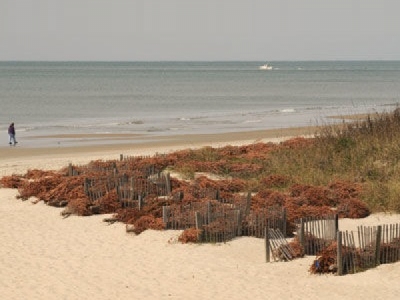
Posted on February 27, 2018
By Mike Shutak, News-Times
Just under a year until the next U.S. Army Corps of Engineers dredging cycle, town officials are going to spend this year pursuing funds for more beach nourishment.
Town Manager David Walker said Friday, after the council’s regular workshop Thursday, that putting sand on the beach as far west as the DoubleTree Hotel by Hilton would cost $1 million. While it wouldn’t raise that much in a year, the council is considering a half-cent property tax rate increase as a longer term solution.
The town council discussed beach nourishment at its planning retreat Jan. 25 and at the workshop Thursday. Mayor Trace Cooper said after a presentation by Carteret County shore protection manager Greg “Rudi” Rudolph this year, town officials are going to seek funds in order to put sand on the public beach west of the town boardwalk at the Circle, a district consisting of the property directly south of the Atlantic Beach Causeway/Fort Macon Road intersection and the surrounding neighborhoods.
Atlantic Beach has an agreement with the ACE to place beach-quality sand dredged from the channel for the state port in Morehead City. However, the ACE only places the sand on the beach once every three years, with the next placement scheduled for 2019, and only from Fort Macon State Park to the beach in front of the Circle.
In order to get the ACE to place sand farther west, town officials must come up with funds to pay the difference in cost for the ACE.
“It’s a bit hard to get a loan for sand,” Mayor Cooper said. “We’ve got a dedicated fund (in the town budget) for sand, so we may just need to pay into that each year.”
Mr. Walker said all other Bogue Banks towns have a beach tax or sand tax in order to raise funds for their own nourishment projects. Councilman Harry Archer said they could consider a half-cent increase on the town’s ad valorem tax rate to help raise the funds.
Mayor Cooper said that on the most recent taxpayer survey, 75 percent of respondents were in support of just such an increase. Mr. Walker said Friday that half a cent on the town’s property tax rate would generate about $80,000 per year.
During his presentation, Mr. Rudolph went over the history of beach nourishment for Atlantic Beach. Prior to 2005, the ACE would put dredged material from the port channel in one of two locations – a point offshore of Atlantic Beach on the ocean side and on Brandt Island on the sound side. Whenever the island disposal site was full, the Corps would pump out material from it onto the beach; this occurred about once every 10 years.
Mayor Cooper, who chairs the Carteret County Beach Commission, said the way the ACE decides how to dispose of dredged material is through a “least-cost policy.”
“To the ACE, it’s not about (beach) nourishment, it’s about navigation,” he said. “We’ve convinced them it’s cheaper to put it on the beach.”
In 2005, when the ACE put dredge material on the beach from Brandt Island, it contained a large amount of mud, making it unsuitable for beach nourishment. Town officials at the time brought this to the ACE attention, and they agreed to place only beach-quality sand from dredging on the beach from then on, once every three years, as long as it can be considered “least cost” to them.
Mr. Rudolph said that since 1999, 14 million cubic yards of sand have been placed on the beaches of Bogue Banks, at a total cost of $123,873,936; this includes recovery projects from hurricanes. Of this amount, the federal government has provided 61 percent or $75,563,100, local interests have provided 32 percent or $39,639,659 and the state about 7 percent or $8,650,175.
There’s another reason, other than a need for nourishment, that the recreational beach might look a bit smaller in recent years. Mr. Rudolph said that due to efforts to use sand fences to build up the dunes, the beaches in Atlantic Beach have grown oceanward, resulting in a narrower recreational beach.
“It’s better for storm protection,” Mayor Cooper said, “but it makes the recreational beach look narrower.”
Mr. Rudolph said that a beach nourishment project, on average, adds about 100 feet of width to a given beach.
Source: News-Times





